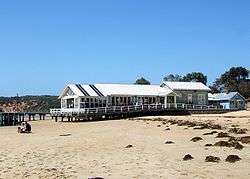Seachange (demography)
In Australian culture, a seachange (or sea change) is a form of human migration that involves individuals abandoning city living in favour of a perceived 'easier life' in rural coastal communities. The term was popularised by the popular Australian ABC TV television series SeaChange, which triggered the phenomenon of many city-dwellers mimicking the drama's protagonist's escape from urban life.[1] It ultimately comes from Shakespeare's The Tempest[2]. The result of this phenomenon (known as the 'sea change effect') is a rapid boom in tourism and real estate development in coastal Australia, particularly in New South Wales.

A similar term, treechange, describes the movement of urbanites to the countryside.
SeaChange
In the television series SeaChange, the main character Laura Gibson fulfils her escapist desire by leaving the city for a small seaside town after her career and family life in Melbourne falls apart. The series, which ran from 1998 to 2000, became one of the most popular programmes in Australia and focused on life outside the big city. The primary filming location for the series at Barwon Heads on the Bellarine Peninsula was the first to experience the seachange effect, with fans of the series both visiting and moving to the community. This experience was replicated in coastal towns across Australia.
Who is shifting
People shifting to the coast have been characterised as:
- Free agent migrators
- Include retirees
- Majority are of working age, drawn to service the needs of retirees and tourists
- Sub categories include pre-retirees, alternative lifestylers and internet business operators
- Forced relocating migrants
- Principally people reliant on income support including unemployed, single parents and the disabled.[3]
Effect
The rate of growth in rural coastal areas is 60% higher than the national average.[4] Almost six million people already reside in coastal areas outside the mainland capitals,[4] and a further one million are expected by 2020. In addition to people seeking a better lifestyle, the seachange phenomenon is driven by retiring baby boomers and people forced out of capital cities by high house prices.[5] It typically involves either the purchase of a secondary (or holiday) home in, or a complete shift to, coastal areas.
The seachange effect is having both positive and adverse effects on local communities. While it has led to increased prosperity in regional areas, the phenomenon has also caused an increased burden on local governments.
In response to the influx of tourists and new residents to their jurisdictions, coastal councils from around Australia formed the National Sea Change Taskforce in 2004 to seek ways to ensure sustainable development in their communities. As at 2008 there are 68 member councils from around Australia collectively representing more than four million residents.[6]
See also
- Elbow roomers, people who leave a city for the countryside to seek more land and greater freedom from governmental and neighborhood interference
References
- "Salty waters and village vibe". The Sydney Morning Herald. 2009-02-14.
- "Sea change". World Wide Words. Retrieved 15 April 2012.
- Dryden, Peter. "Aspects of the 'Sea Change' pheonmenon in the Surf Coast Region of Victoria" (pdf (19 pages)). Australian Government: Bureau of Infrastructure, Transport and Regional Economics. Retrieved 2008-06-25.
- "About the Seachange Taskforce". National Sea Change Taskforce. 2008. Retrieved 2008-06-25.
- The Challenge of Seachange Growth
- "National Sea Change Taskforce". National Sea Change Taskforce. 2008. Retrieved 2008-06-25.